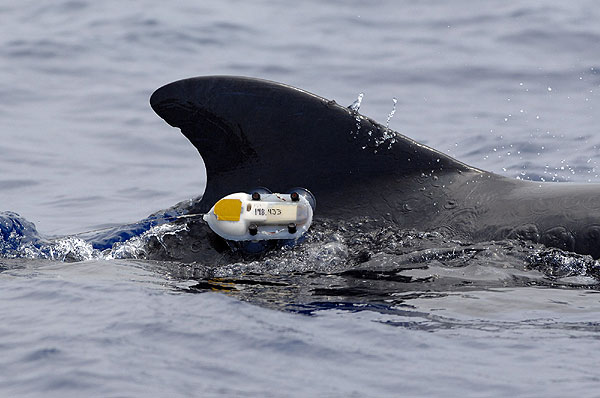US Researchers Observe Whale Reactions to Sonar; UK Report Suggests “Significant” Behavioral Responses
Animal Communication, News, Science, Sonar Add comments
As a new UK Navy report suggests that beaked whales made “potentially very significant” behavioral changes in response to mid-frequency active sonar signals, a team of scientists has just completed a pilot study that involved monitoring the detailed behavior of whales during a major Naval exercise. The UK military report details observations of whale activity during Operation Anglo-Saxon 06, a submarine war-games exercise in 2006. Produced for the UK’s Defence Science and Technology Laboratory, the study used an array of hydrophones to listen for whale sounds during the war games. Across the course of the exercise, the number of whale recordings dropped from over 200 to less than 50. “Beaked whale species appear to cease vocalizing and foraging for food in the area around active sonar transmissions,” said the report. Although the location of Operation Anglo-Saxon 06 has been removed from the report, the pattern of hydrophones shown in one diagram matches that in the US Navy’s AUTEC range in the Bahamas. Meanwhile, the most extenstive field study of behavioral reactions to sonar have just been completed. During the month-long RIMPAC exercises around Hawaii, researchers successfully tagged more than thirty individual marine mammals of four different species. They measured how deep-diving marine mammals feed, interact with one another, dive and respond to sounds in their environment.

A short-finned pilot whale with a Wood’s Hole Oceanographic Institute D-tag attached to its dorsal fin.
(Courtesy of Ari Friedlaender, Duke University)
Some devices recorded short duration bits of detailed information about how the animals move and the sounds they make and hear. Others provide, and continue to provide, longer-term data on their geographical movements around the Hawaiian Islands. About half the tagged animals were pilot whales. Other species included melon-headed whales, false killer whales and Blainville’s beaked whales. “This was the first time that we were ever able to tag these animals around realistic military exercises,” said Brandon Southall, director of the ocean acoustics program for NOAA’s fisheries division and a co-sponsor of the study. It will likely take months to compile the data from the sensors so the whales’ movements can be compared with detailed information on when and where the Navy ships were using sonar. Even then, Southall said, the data won’t be conclusive. But it is a starting point, and he expects whale-tracking projects to coincide with Navy exercises in coming years. A related study will take place this month in the Bahamas, involving tagging whales and playing back sounds similar to sonar and orca calls. Sources: Virginian-Pilot, 8/5/08 [READ ARTICLE] NOAA Press Release, 8/5/08 [READ PRESS RELEASE] Nature News, 8/4/08 [READ ARTICLE] NOAA Behavioral Response Study Website (Bahamas)[WEBSITE]
